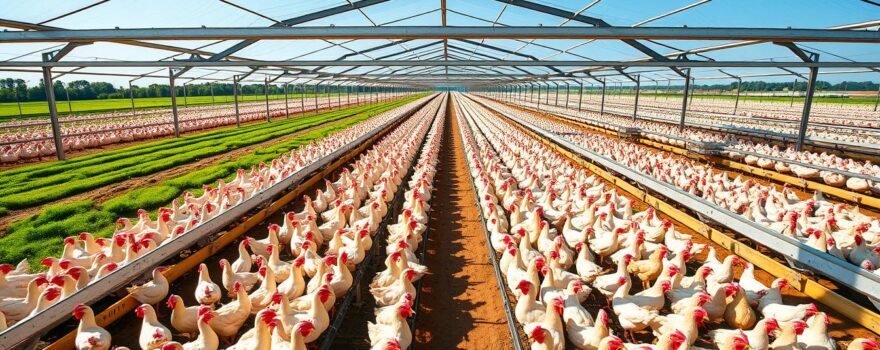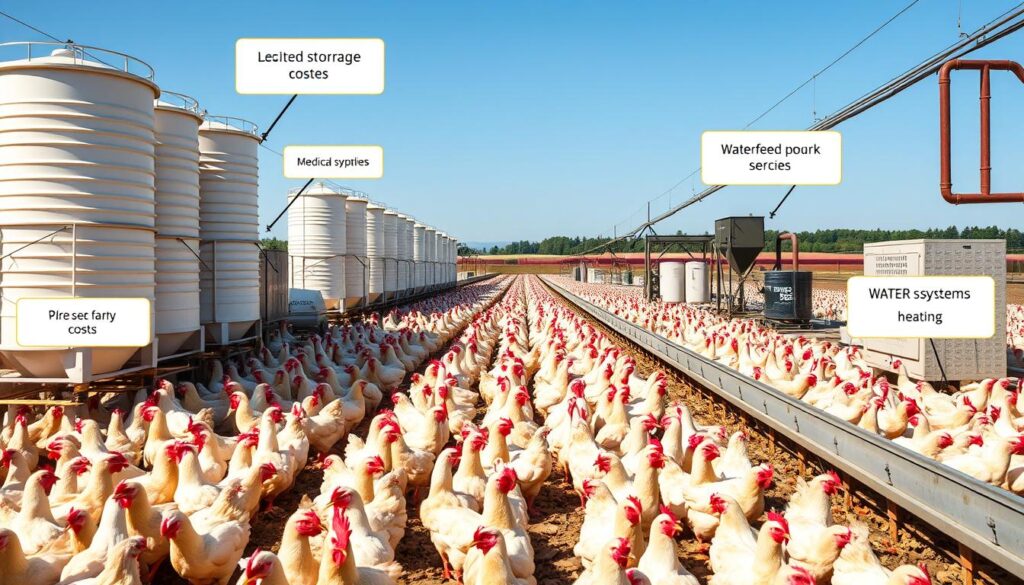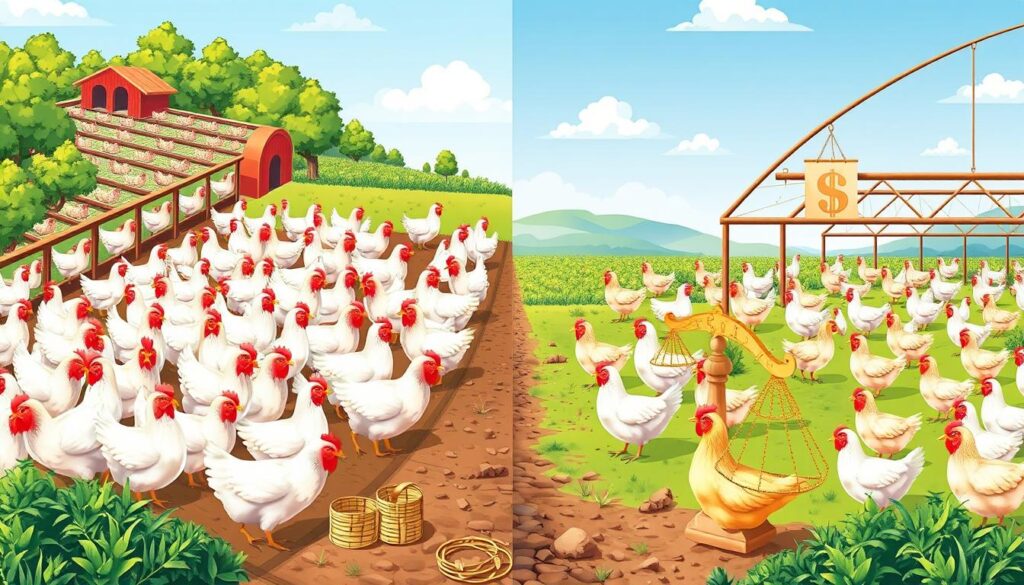
Cost-benefit analysis is key for checking if broiler chicken farming projects are worth it. It looks at all costs and possible profits to see if it’s a good investment. This poultry production cost analysis helps farmers make smart choices, reduce risks, and improve their farms for the future.
For broiler farms, it’s important to check if they can make money and plan well. A detailed financial viability evaluation and economic analysis gives farmers important information. This helps them forecast their finances and make choices that lower risk assessment in broiler farming.
Key Takeaways
- Cost-benefit analysis is crucial for evaluating the financial viability of broiler farming projects.
- It involves estimating all costs and potential profits to determine the overall value of the investment.
- This analysis can help broiler farmers make informed decisions, mitigate risks, and optimize operations.
- Investment feasibility assessment and profitability projection are essential for broiler business planning.
- Conducting a thorough financial viability evaluation and economic analysis can provide valuable insights for poultry ventures.
Introduction to Broiler Farming
In the world of poultry, broiler chickens are key. They are raised for their meat and have grown from small farms to big operations. The broiler farming world has changed a lot. Now, we see both intensive and semi-intensive farming. These methods help meet the demand for broiler chicken farming, poultry production, and a profitable agro industry. This ensures farmers get a continuous flow of income.
What are Broilers?
Broilers are chickens bred for their meat. They grow fast and use feed well, making them popular for commercial farming. Broilers are usually ready for slaughter at 5-7 weeks, when they reach the right weight.
Evolution of Broiler Farming
Before, broiler chickens were raised in small backyard farms. Farmers kept a few birds for their own use or local markets. But, as more people wanted chicken, farming changed. Now, we see more intensive and semi-intensive broiler farming. This change has made farming bigger, more efficient, and able to meet the growing demand for chicken.
Advantages of Broiler Farming
- High profitability: Broiler farming is very profitable, giving farmers a steady income.
- Efficient feed conversion: Broilers turn feed into meat well, saving costs for farmers.
- Rapid growth: Broilers grow fast, reaching market weight in 5-7 weeks. This means more cycles of production each year.
- Versatility: Broiler meat is used in many dishes, meeting different tastes and needs.
The broiler chicken farming industry keeps growing. It’s now a big part of global poultry production. This brings benefits to farmers and consumers, making the agricultural sector strong and dynamic.
What is Cost-Benefit Analysis?
Cost-benefit analysis is a method to figure out all the costs and possible profits in broiler farming. It looks at both quantitative and qualitative factors to see the value of money in the project. It’s important to do this before starting the farm and during production to make smart choices.
Types of Costs in Broiler Farming
In broiler farming, there are two main types of costs:
- Variable Costs: These include things like feed, water, vaccines, and medicines. These costs change with how much you produce and can be managed better.
- Fixed Costs: These are costs that don’t change, like land, poultry houses, feeders, and brooders. These costs are harder to change but can be planned for.
Knowing these cost types is key for a detailed cost analysis procedure. It helps in deciding if the broiler farming project is viable and profitable.

“Broiler farming is considered a profitable agro-industry ensuring a continuous income flow.”
Fixed Costs in Broiler Farming
In broiler farming, fixed costs don’t change, no matter how much you produce. These costs include land, poultry houses, feeders, waterers, and brooders. They are key to making a broiler farm profitable.
The average broiler weighs 1.6 kg, and sells for Rs 380.00 per kg. With 308.8 kg sold, the total income is Rs 117,344.00. But, the fixed costs were Rs 365,800.00, a big part of the expenses.
| Cost Category | Amount (Rs) |
|---|---|
| Expenditure on chicks | 24,000.00 |
| Expenditure on feeds and medicines | 65,980.00 |
| Expenditure on other items | 6,689.00 |
| Total Expenditure | 462,469.00 |
| Profit without considering fixed costs | 20,675.00 |
| Profit taking fixed costs into account | -345,125.00 |
The total profit, after subtracting total expenditure, is a negative Rs -345,125.00. This shows how much fixed costs affect profit. Managing these costs is vital for broiler farmers to stay profitable.
Variable Costs in Broiler Farming
In broiler farming, variable costs change with how much you produce. These costs include feed, medication, labor, and utilities. It’s key for farmers to manage these costs well to stay profitable and keep their farms running smoothly.
Feed and Medication Costs
Feed is the biggest variable cost, making up 60-70% of total costs. Farmers need to watch their feed expenses closely to stay profitable. Medication costs, like vaccines, also add up and are a big part of variable costs.
Labor and Utilities
Labor and utility costs, like electricity and water, are also variable. These costs change based on how big the farm is and its specific needs.
| Variable Cost Category | Estimated Percentage of Total Variable Costs |
|---|---|
| Feed | 60-70% |
| Medication | 10-15% |
| Labor | 15-20% |
| Utilities | 5-10% |
By keeping a close eye on these costs, farmers can make their operations better. This helps them make more money and keep their farms going strong.
How to Conduct a Cost-Benefit Analysis for Broiler Farming Projects
Doing a detailed cost-benefit analysis is key for broiler farming success. It means looking closely at both fixed and variable costs. Also, it’s about figuring out how much money you can make. This helps farmers make smart choices and increase profits.
Data Collection and Analysis
The first thing is to get data from different places. This includes farm records, industry standards, and advice from experts. You need to know all the costs like buying chicks, feed, medicine, labor, and utilities. Also, knowing the live weight, feed conversion ratio, and market age of the broilers helps estimate earnings.
After getting the data, you must analyze it carefully. This helps figure out if the project will make money. You’ll look at things like net income, return on investment (ROI), and breakeven point. This helps farmers make better choices and find ways to get better.
Calculating Profitability
The last step is to figure out how profitable the project will be. You combine data on costs and expected earnings. Farmers should think about the average feed conversion ratio, live weight, and market age to guess profits.
By doing a good cost-benefit analysis, farmers get important insights. This helps them improve operations, find ways to save money, and make smart decisions. These steps lead to more profit and a sustainable future.
Importance of Cost-Benefit Analysis
Cost-benefit analysis is key for broiler farming projects. It helps spot and avoid risks like losing money or making bad choices. By looking at costs and benefits, farmers can make smart decisions and reduce risks.
This analysis also helps farmers understand their project’s financial health. It shows potential profits and where to cut costs. In today’s tight-margin broiler farming world, this is vital.
Risk Mitigation
Cost-benefit analysis is crucial for managing risks in broiler farming. It lets farmers see all costs, including fixed and variable ones. This way, they can plan to avoid financial losses and keep their farm running smoothly.
Informed Decision-Making
Cost-benefit analysis also aids in making better decisions. It gives farmers a clear view of their project’s financial future. This knowledge helps them choose wisely about investments and growth plans.
In short, cost-benefit analysis is vital for broiler farming. It helps manage risks, cut costs, and make smart decisions. This leads to the success and profitability of broiler farming operations.

Strategies to Reduce Costs
Broiler farmers aim to make more money by cutting costs. They focus on feed management and efficient resource utilization.
Feed Management
Good feed management is key to saving money in broiler farming. Giving broilers the right amount of feed each day helps avoid waste. It also makes sure they get the most from their food.
Broilers need about 1.5 to 2 times as much water as food. Keeping the waterer at the right height helps them drink enough water. This cuts down on water waste.
Efficient Utilization of Resources
Managing resources well can also save a lot of money. This includes not overcrowding, using smart lighting, and keeping good records.
Automated broiler houses need less labor, about 4 to 6 minutes a day for every 1,000 birds. Using technology and smart management can lower labor costs.
| Strategies to Reduce Costs | Benefits |
|---|---|
| Portion-controlled feed servings | Minimizes feed waste and optimizes feed efficiency |
| Proper feeder and waterer height management | Encourages adequate feed and water consumption |
| Avoiding overcrowding | Reduces disease risk and improves resource utilization |
| Using dimmable lighting | Saves on energy costs and improves broiler welfare |
| Maintaining thorough record-keeping | Enables data-driven decision-making and cost optimization |
By managing feed and resources wisely, broiler farmers can cut costs. This makes their farms more profitable.
Case Studies and Success Stories
Looking at broiler farming case studies and successful broiler farming projects offers great insights. These examples show how to use cost-benefit analysis well in the broiler industry. They reveal best practices, the effects of cost-saving strategies, and the value of making decisions based on thorough analysis.
Fieldale Farms is a great example. They’ve been around since 1972 and are known for their Springer Mountain Farms brand. This brand is famous for its antibiotic-free, all-vegetarian-fed chicken. They use Tosca’s Reusable Plastic Containers (RPCs) for transporting their poultry.
This move has greatly reduced labor and environmental impact. RPCs have cut down on the number of boxes needed, saving a lot of corrugated material. This has also led to a big drop in greenhouse gas emissions and water usage.
In Syria, a renewable energy heating system was introduced in chicken farms. It cut coal use by 57% and paid off in 5 years with geothermal heat pumps. In Egypt, using renewable energy for heating was also seen as a cost-effective choice compared to fossil fuels.
These examples show the real benefits of using cost-saving strategies and renewable energy in broiler farming. By studying these cases, farmers can learn how to make their operations more profitable and sustainable.
| Project | Key Outcomes |
|---|---|
| Fieldale Farms (Springer Mountain Farms) |
|
| Renewable Energy Heating System in Syria |
|
| Renewable Energy Heating System in Egypt |
|
These stories and examples show the potential for cost savings and sustainability in broiler farming. By learning from these, farmers can make better decisions and improve their operations’ profitability and environmental impact.
Doing a detailed cost-benefit analysis is key for broiler farmers to make sure their business is financially sound. They need to look at both fixed and variable costs. This helps them spot ways to save money and predict how much they can earn.
Looking at fixed costs like buying facilities and equipment, and variable costs like feed and labor, helps farmers understand their financial needs. Finding ways to use resources better and cut costs can also boost profits.
With a good cost-benefit analysis, farmers can make smart choices, handle risks, and grow their business. This careful planning helps them succeed in the ever-changing broiler farming world. It prepares them to take advantage of the many chances the industry offers.